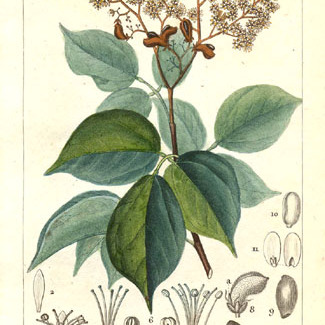Erect or scandent shrubs, small trees or lianes. Leaves alternate, unifoliolate or imparipinnate; stipules and stipellae absent. Inflorescence terminal or axillary, paniculate or racemose, often fascicled in axils of older leaves or on older branchlets. Flowers hermaphrodite, rarely dioecious,1 actinomorphic, usually pentacyclic, androecium and gynoecium often dimorphic or heteromorphic. Sepals 5, imbricate or valvate, usually free. Petals 5, free or lightly connate near base. Stamens 10, 5 episepalous longer than 5 epipetalous, the latter sometimes reduced and staminodal; filaments free or connate into a short tube at base; anthers dorsifixed, usually with longitudinal introrse dehiscence. Carpels 5 or solitary, rarely 3, free; ovules normally 2, basal or attached to ventral suture, collateral, anatropous or orthotropous, erect. All carpels apparently fertile but usually only 1–3 mature. Fruit usually follicular, dehiscence by ventral suture, sometimes indehiscent or dehiscence irregular. Seed solitary, with ± fleshy aril covering part or all of the seed; aril free or sometimes fused with testa to form a compound fleshy pseudo-aril. Endosperm abundant, rudimentary or absent; cotyledons plano-convex, fleshy, or much flattened and small; radicle apical or laterally displaced
Carpels 5 or solitary, rarely 3, free, 1-locular; apparently all fertile but only 1–3 ripening into fruit; ovules 2, collateral, erect, attached at the base, near the base or near the middle of the ventral suture
Stamens 10 or 5, hypogynous to perigynous; filaments often united at the base; anthers 2-thecous, dorsifixed, with longitudinal introrse dehiscence
Stamens hypogynous to perigynous, often declinate, 5 or 10; filaments often united at the base; anthers 2–celled, opening lengthwise
Ovules 2, collateral, erect, attached near the base or the middle of the ventral suture, all or only 1 ripening into fruit
Fruit usually follicular, dehiscing by the ventral suture, sometimes indehiscent or dehiscing irregularly
Flowers usually bisexual, actinomorphic or subzygomorphic; androecium and gynoecium usually dimorphic
Seed usually 1 in each follicle, with or without endosperm, often arillate or pseudarillate
Leaves alternate, imparipinnate or 1–3-foliolate, leaflets entire; stipules absent
Erect or scandent shrubs, small trees or lianes, rarely rhizomatous shrublets
Petals 5, free or slightly connate near the base, imbricate or rarely valvate
Leaves alternate, compound, imparipinnate or 1–3-foliolate; stipules absent
Petals 5, free or sometimes slightly connate, imbricate or rarely valvate
Flowers hermaphrodite, actinomorphic or slightly zygomorphic
Seeds usually 1, with or without endosperm, often arillate
Fruit often splitting down one side exposing the seed
Sepals 5, imbricate or valvate, usually free
Erect trees or shrubs, or scandent
Carpels 1–5, free, 1–celled
Calyx imbricate or valvate
Disk absent or thin
Disk absent or thin

